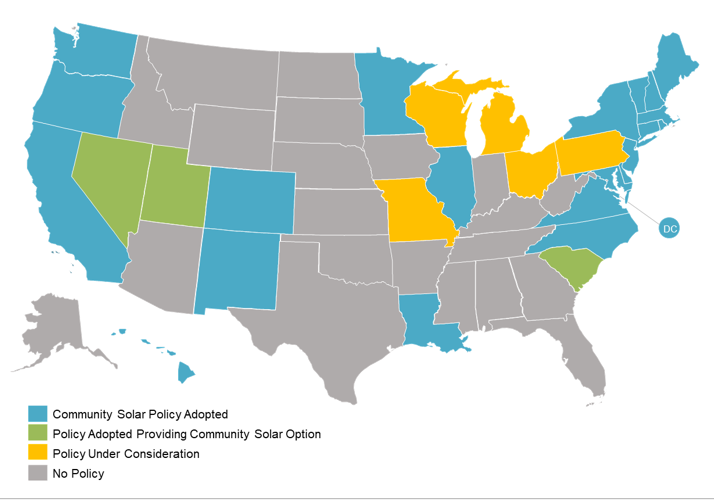By: David Sarkisian, Senior Project Manager
Community solar is a program model allowing people, businesses, and organizations to purchase shares or subscriptions to the output of larger-scale solar projects. It provides an avenue for access to solar energy for people who cannot, or prefer not to, install rooftop solar panels. Community solar programs can be offered by electric utilities, and in many states community solar programs allow participation by third-party providers.
In the Midwest, community solar has historically had a foothold in Minnesota, which currently has the largest amount of third-party community solar capacity of any state. More recently, Illinois has seen considerable community solar activity in connection with its 2016 Future Energy Jobs Act, which established two REC-based incentive programs for community solar (and other solar) development. Illinois’ 2021 clean energy legislation, the Climate and Equitable Jobs Act, continues and expands the state’s support for community solar.
Throughout 2021, several other states in the Midwest and Great Lakes region have shown interest in third-party community solar legislation. These states include Michigan, Missouri, Ohio, Pennsylvania, and Wisconsin. Currently, legislators in all five of these states have introduced (or pre-filed) legislation that would establish third party-led community solar programs. All of these bills are still in the very early stages of the legislative process, but it will be interesting to see how they develop through the end of 2021 and into 2022. The different bills are discussed below.
State Community Solar Policies (December 2021)
Michigan
Michigan legislators have introduced two different bills that would establish a third-party community solar program. One of these bills, H.B. 4715, leaves most of the specifics of program design to the state Public Service Commission, while the other bill, H.B. 4716, creates more specific requirements for the program, setting a maximum system size of 5 MW and establishing credit rates using Michigan’s inflow-outflow DG compensation methodology. These bills were introduced in April 2021, so their prospects for action in 2021 are not clear, but the Michigan legislature meets year-round, so it is possible that they will yet be acted on this year.
Missouri
In early December 2021, Missouri legislators pre-filed two community solar bills for the 2022 session. Both Missouri bills cap community solar capacity at relatively limited levels; one bill, H.B. 1536, allows for a total of 6 MW of community solar garden capacity per electric utility until 2026, while the other bill, S.B. 824, limits total solar electricity provision under the program to 2% of the relevant utility providers’ electricity sales. The bills also have different individual system size limits, with H.B. 1536 initially requiring systems to be no more than 500 kW, while S.B. 824 would allow for systems up to 5 MW.
Ohio
Lawmakers in Ohio introduced two separate community solar bills in fall 2021. Interestingly, both Ohio bills would allow for retail rate crediting of community solar subscribers. H.B. 429 would allow for virtual net metering and envisions it to be used to facilitate community solar programs. H.B. 450 also requires community solar subscribers to be credited using net metering. H.B. 429 does not specifically limit aggregate or system capacity, while H.B. 450 has a total limit of 2 GW (plus an additional 1 GW specifically for distressed sites), and a system size limit of 10 MW (45 MW for distressed sites). H.B. 450 also requires that a majority of total capacity be deployed in the Appalachian region.
Pennsylvania
Pennsylvania currently has two community solar bills under consideration: H.B. 1396 and H.B. 1555. The two bills differ on their crediting method; H.B. 1396 calls for crediting based on net metering, while H.B. 1555 would use a value stack method based on prices from the PJM markets. The bills also have slightly different individual system size limits (3 MW for H.B. 1396 and 5 MW for H.B. 1555). Both bills require that no one subscriber be allowed to subscribe to more than 50% of a facility’s capacity, except in the case of master-metered multifamily buildings. Both bills also include provisions aiming to make the programs accessible to lower-income customers; H.B. 1396 calls for a minimum participation target for low and moderate-income customers, while H.B. 1555 would require that subscription costs not exceed the value of bill credits and disallow upfront costs for low-income customers.
Wisconsin
Wisconsin legislators introduced companion bills on community solar in August and September 2021. A.B. 527 and S.B. 490 would create a third-party community solar program. The program would have an individual system size cap of 5 MW, but, interestingly, the bills do not appear to require an aggregate capacity limitation; this would make the program similar to the one in neighboring Minnesota. The Wisconsin bills also do not explicitly set a credit rate for community solar projects, instead requiring that the state Public Service Commission set the credit rate at a level that results in “robust” community solar development. A proposed amendment to the bills would change this provision to instead require the credit rate be based on the full economic value provided by the solar facilities.

